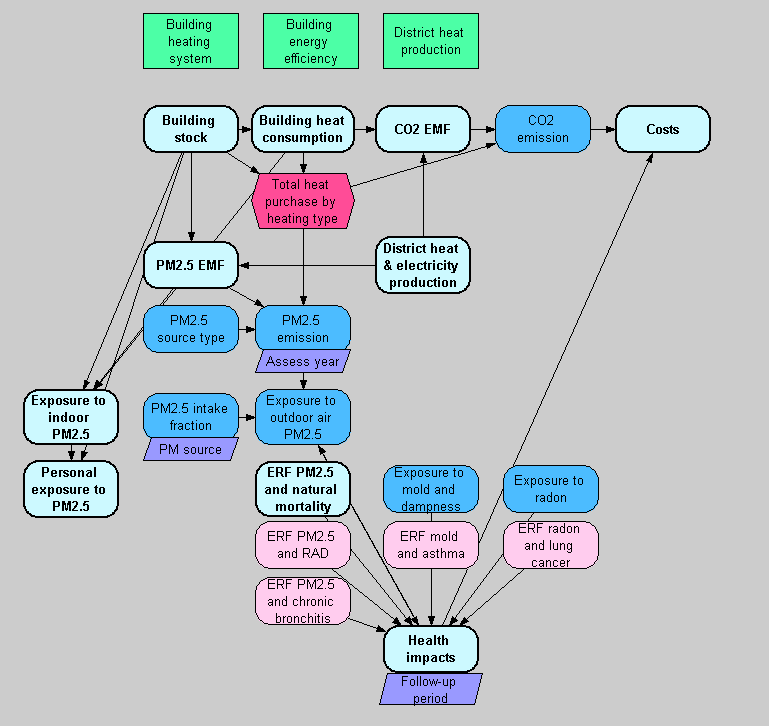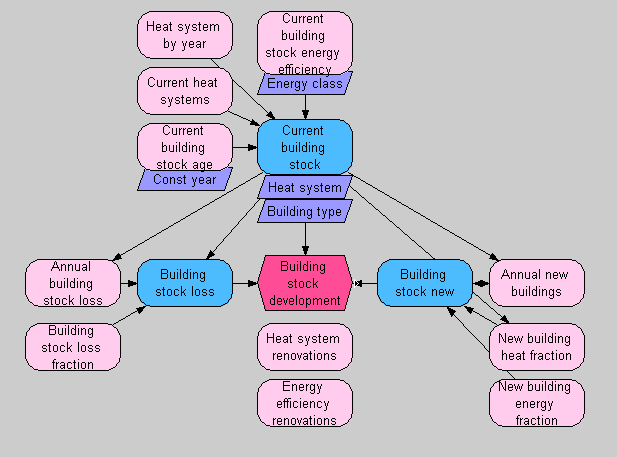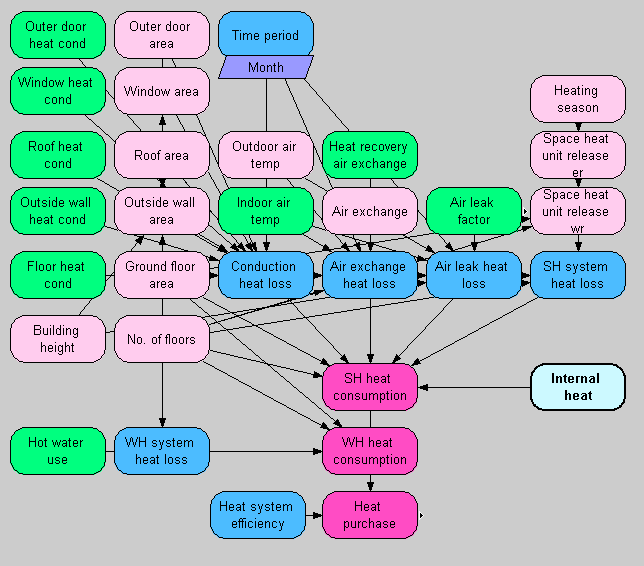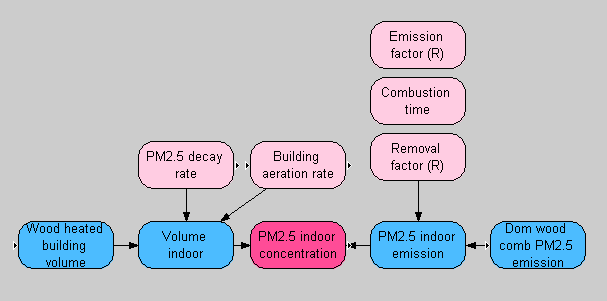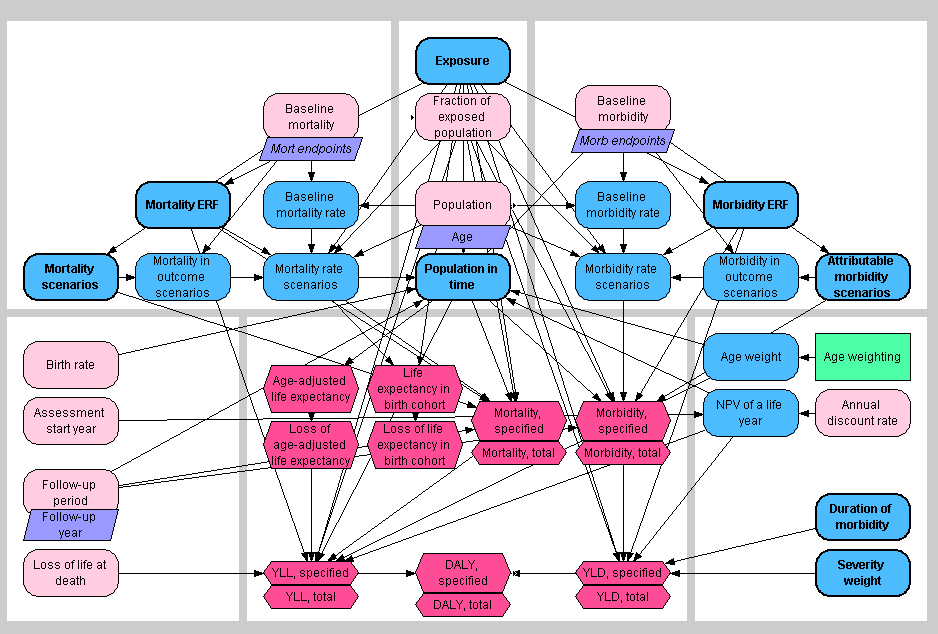CLAIH assessment: Difference between revisions
mNo edit summary |
|||
| (30 intermediate revisions by 3 users not shown) | |||
| Line 6: | Line 6: | ||
[http://en.opasnet.org/w/Image:Claih_model.ANA CLAIH analytica model ] | [http://en.opasnet.org/w/Image:Claih_model.ANA CLAIH analytica model ] | ||
== Scope == | == Scope == | ||
| Line 13: | Line 11: | ||
=== Purpose === | === Purpose === | ||
The purpose of the assessment is to evaluate cost-effectiveness of different measures | The purpose of the assessment is to evaluate cost-effectiveness of different measures to reduce green house gas emissions from household heating in Finland when costs from indirect health impacts of the measures are also taken into consideration. | ||
More specifically: | More specifically: | ||
*What would be the | *What would be the health impacts of different options for heating system and energy efficiency renovations in detached houses constructed in 1960-1970? | ||
*From the | *From the society's point of view, what would be the most cost-effective (combinations of) measures to reduce green house gas emissions from this type of houses? | ||
* | *Is there a conflict between the cost-effectiveness of different measures when either a society or a house owner is considered? | ||
=== Boundaries === | === Boundaries === | ||
| Line 29: | Line 26: | ||
*Population: Finland | *Population: Finland | ||
*Assessment time frame: 2010-2030 | *Assessment time frame: 2010-2030 | ||
*Evaluated activity: heat | *Evaluated activity: heat consumption in detached houses | ||
*Evaluated exposures: | *Evaluated exposures: | ||
**Fine particles (PM2.5) | **Fine particles (PM2.5) | ||
**Indoor Radon | |||
**Indoor dampness and mold | **Indoor dampness and mold | ||
*Evaluated health impacts: | *Evaluated health impacts: | ||
**Mortality and morbidity due to long term exposure to PM2.5 | **Mortality (and morbidity?) due to long term exposure to PM2.5 | ||
** | **Lung cancer mortality due to indoor radon | ||
**Asthma due to indoor mold and dampness | **Asthma due to indoor mold and dampness | ||
*Other evaluated emissions: CO2 | *Other evaluated emissions: CO2 | ||
*Evaluated costs: | *Evaluated costs for a house owner: | ||
** | **Cost of heating system renovation (investment, interest) | ||
** | **Cost of energy efficiency renovations (investment, interest) | ||
**Cost of heat consumption (heat energy, maintenance) | |||
** | *Evaluated costs for society: | ||
* | **Costs for house owner (excluding taxes) | ||
**Cost of health impacts | |||
** | **Cost of CO2 emissions | ||
** | |||
** | |||
** | '''Specific decisions evaluated''' | ||
** | |||
*New heating system | |||
**Light oil | |||
**Pellet | |||
**District heating | |||
**Direct electricity + air heat pump | |||
**Ground source heat pump (GSHP) | |||
*Form of district heat production (evaluated only in terms of PM2.5 health impacts) | |||
**BAU | |||
**Small scale power plant (<5 MW), wood | |||
**Small scale power plant (<5 MW), oil | |||
* | *Energy efficiency renovation | ||
** | **BAU (no renovation) | ||
** | **New windows | ||
** | ***(U factor 1 W/m2K, air leak factor reduced by 20% to 0.24/h) | ||
* | **New windows + increased insulation for walls and roof | ||
** | ***Wall U factor 0.17 W/m2K | ||
***Roof U factor 0.09 W/m2K | |||
***Air leak factor reduced by 50% to 0.16/h | |||
**New windows + increased insulation for walls and roof + heat recovery ventilation | |||
***Heat recovery efficiency 60% | |||
'''Emissions, health impacts, and costs are evaluated for:''' | |||
*An average detached house constructed in 1960-1970 | |||
**The house is in need of basic renovations unrelated to energy efficiency improvements | |||
***New heating system (excluding heat distribution system) | |||
***New windows | |||
***Wall renovation | |||
*All houses houses similar to the one described above in the Finnish building stock? | |||
**All changed at the start of the assessment follow-up period? | |||
**Changed gradually throughout the assessment follow-up period? | |||
=== Intended users === | === Intended users === | ||
| Line 81: | Line 96: | ||
*Anyone interested | *Anyone interested | ||
== | == Answer == | ||
=== Results === | === Results === | ||
| Line 337: | Line 352: | ||
== Rationale == | == Rationale == | ||
===Plan for uncertainty calculations=== | |||
The final endpoint of the Claih model is '''Cost share''' (or total cost, which is the same with cost factors summed up). The health cost part is the heavy part of the model. Thus, if the heavy chain that ends to '''Total cost of lost life years''' can be removed and calculated outside Analytica, then all other parts can be calculated there. The idea is that Analytica calculations are converted by MDArrayToTable into a 2D table with Run as one index. This is exported to a file and then imported to R-tools as a static input. | |||
In Analytica, a new node '''Cost share w/o health''' is needed: it calculates everything ecxept health, and is then exported to Opasnet. The final cost calculations and VOI analysis is done in Opasnet. | |||
To calculate health impacts, the following nodes must be recoded in R and computed there: | |||
* YLL total | |||
* YLL, specified | |||
** Mortality, specified | |||
*** Population in time, average for time step * | |||
**** Population in time child * | |||
***** Birth rate | |||
** Age-adjusted life expectancy | |||
*** Population in time, beginning of time step * | |||
** Age weight | |||
** Life years in time | |||
** PV of a life year | |||
* Year help | |||
* Value of a life year | |||
* Present value | |||
* VOI (this is a function) | |||
<nowiki>*</nowiki> These three nodes have the most complex code. | |||
Also, these input nodes must be calculated in Analytica, converted, and exported to R-tools: | |||
* Mortality risk scenarios | |||
* Population data | |||
The downside of this plan is that it may take up to two weeks of working time to convert the Analytica code to R. This may only be worth it, because ICT is to be converted to R anyway, and making this part now would have immediate utility for Bioher and Claih. | |||
===Decisions to be evaluated=== | |||
[[Image:Claih model.PNG]] | [[Image:Claih model.PNG]] | ||
'''''Figure: CLAIH assessment overview''''' | '''''Figure: CLAIH assessment overview''''' | ||
''Society:'' | ''Society:'' | ||
| Line 377: | Line 423: | ||
'''''Figure: Building heat consumption modelling''''' | '''''Figure: Building heat consumption modelling''''' | ||
*[[ | *[[Unit heat consumption of buildings in Finland]] | ||
| Line 517: | Line 562: | ||
*[http://www.oecd.org/document/62/0,3746,en_2649_34281_36144679_1_1_1_1,00.html#How_to_Obtain OECD 2006: Cost-Benefit Analysis and the Environment: Recent Developments] | *[http://www.oecd.org/document/62/0,3746,en_2649_34281_36144679_1_1_1_1,00.html#How_to_Obtain OECD 2006: Cost-Benefit Analysis and the Environment: Recent Developments] | ||
*[http://www.stakes.fi/verkkojulkaisut/tyopaperit/T3-2008-VERKKO.pdf Hujanen et al. 2008: Terveydenhuollon yksikkökustannukset Suomessa 2006.] | *[http://www.stakes.fi/verkkojulkaisut/tyopaperit/T3-2008-VERKKO.pdf Hujanen et al. 2008: Terveydenhuollon yksikkökustannukset Suomessa 2006.] | ||
*[http://www.who.int/choice/publications/p_2003_generalised_cea.pdf WHO 2003: WHO guide to cost-effectiveness analysis] | *[http://www.who.int/choice/publications/p_2003_generalised_cea.pdf WHO 2003: WHO guide to cost-effectiveness analysis] | ||
*[http://www.ktl.fi/attachments/suomi/julkaisut/julkaisusarja_b/2002b5.pdf Husman 2002. Kosteusvauriotaloissa asuneiden perheiden pitkäaikaiset terveyshaitat ja asumisterveysongelmista aiheutuneet kustannukset] | *[http://www.ktl.fi/attachments/suomi/julkaisut/julkaisusarja_b/2002b5.pdf Husman 2002. Kosteusvauriotaloissa asuneiden perheiden pitkäaikaiset terveyshaitat ja asumisterveysongelmista aiheutuneet kustannukset] | ||
| Line 526: | Line 570: | ||
*[http://www.motiva.fi/files/4248/Lampokeskuksesta_asiakkaalle_Turun_Asennus_ja_Luokkahitsarit_.pdf Kaukolämpö (katso viimeinen sivu)] | *[http://www.motiva.fi/files/4248/Lampokeskuksesta_asiakkaalle_Turun_Asennus_ja_Luokkahitsarit_.pdf Kaukolämpö (katso viimeinen sivu)] | ||
*[http://www.motiva.fi/rakentaminen/lammitysjarjestelman_valinta/vertaile_lammitysjarjestelmia/lammitysjarjestelmien_kustannukset/ Motiva: Costs of heating systems] | *[http://www.motiva.fi/rakentaminen/lammitysjarjestelman_valinta/vertaile_lammitysjarjestelmia/lammitysjarjestelmien_kustannukset/ Motiva: Costs of heating systems] | ||
*[http://www.biohousing.eu.com/ BioHousing] | |||
*[http://webhotel2.tut.fi/ee/index.html Energia- ja elinkaariryhmä, Tamperee teknillinen yliopisto] | |||
*[http://www.vtt.fi/inf/julkaisut/muut/2005/asuinrakennukset_vuoteen_2025.pdf VTT 2005. Asuinrakennukset vuoteen 2025.] | |||
*[http://www.vtt.fi/inf/pdf/tiedotteet/2007/T2377.pdf VTT 2007. SUomalaisten rakennusten energiakorjausmenetelmät ja säästöpotentiaalit] | |||
*Tampereen teknillinen yliopisto, rakennustekniikan laitos, 2008. Tutkimusselostus. Matalaenergiarakenteiden toimivuus. Tutkimustuloksia ja suosituksia uusiin lämmöneristys- ja energiakulutusmääräyksiin ja -ohjeisiin, loppuraportti. | |||
*[http://www.ymparisto.fi/download.asp?contentid=96145&lan=FI VTT 2008. Lausunto rakenteiden energiatehokkuuden parantamisen vaikutuksista rakenteiden kosteustekniseen tomivuuteen.] | |||
*Lomake YM 33a/05: Omakotitalon perusparantaminen. Toimenpide- ja kustannusluettelo. | |||
*[https://publications.theseus.fi/bitstream/handle/10024/17056/Nikkila_Ville.pdf?sequence=1 Nikkilä 2010. Pientalon lämmitysjärjestelmän saneeraus - Taloudellisia ja ympäristöllisiä näkökulmia] | |||
*[http://ffrc.utu.fi/julkaisut/e-julkaisuja/eTutu_2006-1.pdf ILMASTOLIIKETOIMINTA JA ENERGIA SUOMESSA 2050 (ILMES) – SKENAARIOT JA STRATEGIAT] | |||
*[https://publications.theseus.fi/bitstream/handle/10024/12330/TRT5STuomasT.pdf?sequence=1 Tervonen, T. 2009. Omakotitalon lämmityskärjestelmän valinta] | |||
*[http://www.vtt.fi/inf/pdf/tiedotteet/1999/T1974.pdf VTT 1999. Vihreän energian kriteerit ja elinkaariarviointi energiatuotteiden ympäristökilpailukyvyn arvioinnissa.] | |||
*[http://energia.awardspace.info/ Sähköntuotannon päästölaskuri (huomioi kaikki elinkaaren aikaiset päästöt).] | |||
*[http://www.energia.fi/sites/default/files/primaarienergia_ja_kaukolammon_kilpailukyky_gaia.pdf Bröckl et al. 2010. Primäärienergia ja kaukolämmön kilpailukyky. Gaia Consulting Oy.] | |||
*Suomen Rakennusinsinöörien liitto 2009. RIL249-2009. Matalaenergiarakennukset. Asuinrakennukset. | |||
*[http://www.eea.europa.eu/about-us/governance/scientific-committee/sc-opinions/opinions-on-scientific-issues/sc-opinion-on-greenhouse-gas EEA 2011, Opinion of the EEA Scientific Committee on Greenhouse Gas Accounting in Relation to Bioenergy, European Environment Agency Scientific Committee 15.9.2011] | |||
*[http://www.birdlife.org/eu/pdfs/carbon_bomb_21_06_2010.pdf Bioenergy: a carbon accounting time bomb] | |||
*[http://www.pacinst.org/reports/Bioenergy_and_Greenhouse_Gases/Bioenergy_and_Greenhouse_Gases.pdf Morris, G. 2008. Bioenergy and greenhouse gases. Green Power Institute, The Renewable Energy Program of the Pacific Institute, Berkeley, California.] | |||
*[http://ec.europa.eu/energy/energy2020/roadmap/doc/com_2011_8852_en.pdf European Commission 2011: Energy Roadmap 2050] | |||
*[http://www.helen.fi/pdf/Helen_2020_kehitysohjelma.pdf Helsingin Energian kehitysohjelma kohti hiilineutraalia tulevaisuutta 12.1.2010] | |||
*[http://www.energia.fi/sites/default/files/energiaverovertailu_versio_14012011.pdf Rantakokko, J.-P. 2010. Kansainvälinen energiaverovertailu. Energiateollisuus ry.] | |||
Latest revision as of 11:32, 13 March 2015
| Moderator:Virpi Kollanus (see all) |
|
|
| Upload data
|
Climate change, air quality and housing – future challenges to public health (CLAIH)
Scope
Purpose
The purpose of the assessment is to evaluate cost-effectiveness of different measures to reduce green house gas emissions from household heating in Finland when costs from indirect health impacts of the measures are also taken into consideration.
More specifically:
- What would be the health impacts of different options for heating system and energy efficiency renovations in detached houses constructed in 1960-1970?
- From the society's point of view, what would be the most cost-effective (combinations of) measures to reduce green house gas emissions from this type of houses?
- Is there a conflict between the cost-effectiveness of different measures when either a society or a house owner is considered?
Boundaries
- Population: Finland
- Assessment time frame: 2010-2030
- Evaluated activity: heat consumption in detached houses
- Evaluated exposures:
- Fine particles (PM2.5)
- Indoor Radon
- Indoor dampness and mold
- Evaluated health impacts:
- Mortality (and morbidity?) due to long term exposure to PM2.5
- Lung cancer mortality due to indoor radon
- Asthma due to indoor mold and dampness
- Other evaluated emissions: CO2
- Evaluated costs for a house owner:
- Cost of heating system renovation (investment, interest)
- Cost of energy efficiency renovations (investment, interest)
- Cost of heat consumption (heat energy, maintenance)
- Evaluated costs for society:
- Costs for house owner (excluding taxes)
- Cost of health impacts
- Cost of CO2 emissions
Specific decisions evaluated
- New heating system
- Light oil
- Pellet
- District heating
- Direct electricity + air heat pump
- Ground source heat pump (GSHP)
- Form of district heat production (evaluated only in terms of PM2.5 health impacts)
- BAU
- Small scale power plant (<5 MW), wood
- Small scale power plant (<5 MW), oil
- Energy efficiency renovation
- BAU (no renovation)
- New windows
- (U factor 1 W/m2K, air leak factor reduced by 20% to 0.24/h)
- New windows + increased insulation for walls and roof
- Wall U factor 0.17 W/m2K
- Roof U factor 0.09 W/m2K
- Air leak factor reduced by 50% to 0.16/h
- New windows + increased insulation for walls and roof + heat recovery ventilation
- Heat recovery efficiency 60%
Emissions, health impacts, and costs are evaluated for:
- An average detached house constructed in 1960-1970
- The house is in need of basic renovations unrelated to energy efficiency improvements
- New heating system (excluding heat distribution system)
- New windows
- Wall renovation
- The house is in need of basic renovations unrelated to energy efficiency improvements
- All houses houses similar to the one described above in the Finnish building stock?
- All changed at the start of the assessment follow-up period?
- Changed gradually throughout the assessment follow-up period?
Intended users
- Ministry of Employment and the Economy
- Ministry of Social Affairs and Health
- Ministry of the Environment
- Any interested party
Participants
- FMI
- University of Oulu
- THL: Virpi Kollanus, Pauliina, Marko, Mikko Pohjola, Jouni
- Anyone interested
Answer
Results
The objective of the preliminary assessment has been to find out the current level of health impacts related to residential heating and indoor air exposures. The future results (year 2030) have been calculated assuming that things in housing stay pretty much the same as they are now. However, population aging is taken into account.
The preliminary results are based on the following assumptions:
Building stock:
- Annual building stock loss is 0.3%. Only buildings older than 50 years are pulled down.
- Annual new building stock construction is determined based on the annual building stock loss (0.3%) and annual increase in the residential surface area per person (0.7%)
- All new buildings are current standard in energy efficiency.
- Fraction of heating systems in new buildings is the same as in the buildings constructed between 2000-2010.
- No heating system/energy efficiency renovations are done in the current building stock.
- Energy efficiency of buildings constructed at different decades is based on the building restrictions at the construction time.
Energy production/consumption:
- District heat production:
- 75% in large CHP plants, 25% in small scale heat production plants
- Fraction of used fuels is based on the year 2008.
- These are assumed to stay the same in the future.
- Electricity production (fuel fractions) is based on the year 2008. This is assumed to stay the same in the future.
- Only primary heating systems in the residential buildings are included in the assessment.
- Fraction of the combustion techniques used in the domestic wood heating is based on fractions used for primary wood heating in KOPRA-project.
- Temperature increase due to climate change is not taken into account.
PM2.5 exposure:
- Only emissions to outdoor air are included in the assessment.
- PM2.5 emission intake fraction for domestic combustion is based on the PILTTI-project.
- PM2.5 emission intake fraction for large and small power plants are based on KOPRA-project.
- Exposure-response function (RR) for PM2.5 exposure and natural mortality is based on the Tuomisto et al. 2008 expert eliciation study (0.97% (90% Cl 0.02-4.54) per 1 µg/m3 increase in PM2.5.
- Exposure-response function (AR) for PM2.5 exposure and new cases of chronic bronchitis (age group >27) is 0.0000533 (95% Cl 0.0000017-0.000113) per 1 µg/m3
- Exposure-response function (AR) for PM2.5 exposure and restricted activity days (RADs) (age group 15-64) is 0.902 (95% Cl 0.792, 1.013) per 10 µg/m3
Mold and dampness exposure:
- Prevalence of mold and dampness exposure in Finnish residences is 15% This is assumed to stay the same in the future.
- Exposure-response function for mold and dampness exposure and current asthma is all age groups is 1.56 (1.30–1.86) (Odds ratios for asthma in homes with vs. without visible dampness and/or mold or mold odor)
- Asthma prevalence in Finnish population is 8% (assumed to be the same in all age groups)
Radon exposure:
- Average radon concentration in Finnish residences is 120 Bq/m3. This is assumed to stay the same in the future.
- Exposure-response function (RR) for radon exposure in home and lung cancer mortality is 1.16 (95 % CI 1.05 - 1.31) per 100 Bq/m3.
Population:
- Assessment takes into account population aging
- Baseline risk of natural mortality and lung cancer mortality is assumed to stay on the year 2008 level.
Results:
Total heat purchase of residential buildings by heating type, kWh/a
| Heating type | 2010 | 2030 |
| District | 1.84G | 1.99G |
| Light oil | 1.53G | 1.38G |
| Wood | 1.02G | 1.03G |
| Electricity | 1.83G | 1.98G |
| Geothermal | 0.35G | 0.54G |
| Other | 0.78G | 0.92G |
Total PM2.5 emission from residential building heat production, t/a
| PM2.5 source | 2010 | 2030 |
| Domestic combustion | 6000 | 5880 |
| Small power plants (<50 MW) | 290 | 310 |
| Large power plant | 820 | 890 |
Average population exposure to PM2.5 due to residential heat production, µg/m3
| PM2.5 source | 2010 | 2030 |
| Domestic combustion | 0.53 | 0.53 |
| Small power plants (<50 MW) | 0.005 | 0.005 |
| Large power plant | 0.01 | 0.01 |
Annual health impact of PM2.5 exposure from residential building heating. DALY: disability adjusted loss of life years.
| Health endpoint | 2010 | 2030 |
| Attributable deaths (all natural) | 283 | 373 |
| DALY: mortality | 3177 | 3583 |
| Attributable new chronic bronchitis cases | 107 | 101 |
| DALY: new chronic bronchitis cases | 129 | 121 |
| Attributable restricted activity days (RAD) | 166100 | 133500 |
| DALY: RAD | 45 | 36 |
Annual health impact of exposure to indoor mold and dampness. DALY: disability adjusted loss of life years.
| Health endpoint | 2010 | 2030 |
| Attributable cases: asthma | 28090 | 27260 |
| DALY: asthma | 1657 | 1608 |
Annual health impact of exposure to indoor radon. DALY: disability adjusted loss of life years.
| Health endpoint | 2010 | 2030 |
| Attributable lung cancer deaths | 381 | 440 |
| DALY: lung cancer mortality | 5782 | 5936 |
Things to discuss in the meeting:
Mold and dampness
- Relevance of the asthma prevalence assumption
- Relevance of the exposure-response function for mold and dampness exposure and asthma
- Other possible health endpoints for mold and dampness exposure
- Relevance of the used mold and dampness exposure indicator
- Factors related to mold and dampness exposure and health effects
- Important things to consider when modelling changes in building stock and the effect these changes have on the mold and dampness exposure and their health effects
PM
- Updates for PM emission factors?
- Updates for fractions of domestic wood burning devices?
- Health endpoints included. Options:
- Natural mortality (PM2.5, long-term exposure)
- Cardiovascular mortality (PM2.5, long-term exposure)
- Lung cancer (PM2.5, long-term exposure)
- New chronic bronchitis cases (PM2.5, long-term exposure)
- Restricted activity days (PM2.5, short-term exposure)
- Work loss days (PM2.5, short-term exposure)
- Minor restricted activity days (PM2.5, short-term exposure)
- Lower respiratory symptoms (PM10, short-term exposure)
- Cardiovascular hospital admissions (PM10, short-term exposure)
- Respiratory hospital admissions (PM10, short-term exposure)
- Medication usage by people with asthma (PM10, short-term exposure)
- Should secondary PM2.5 be included in the assessment?
- Possibilities for exposure modelling (intake fractions are only for primary PM2.5)
- Should PM10 be included in the assesment?
- Possibilities for exposure modelling
- PM exposure assessment: outdoor air concentrations vs. personal exposure approach
Heat
- Heat exposure impact assessment is a separate assessment.
- Building stock development does affect heat exposure, but it would be very dificult to evaluate health impacts from this.
- However, the effects of the building energy efficiency solutions on indoor temperatures can, perhaps, be analysed in some other qualitative or quantitative terms.
General issues
- Assessment focus, specific questions asked, issues included
- As of now, possible decisions on the following issues are to be assessed:
- Heating options for new residential buildings
- Heating system renovations in old building stock
- Energy efficiency in new building stock
- Energy efficiency renovations as part of general renovations in old building stock
- Improved wall insulation
- Heat recovery from air exchange
- Improved window insulation
- Air filtering in residential buildings
- Form of district heat production (more small scale production?)
- Fuel options for district heat production
Main objective is to answer: what would be to most cost-effective policy options for the society to reduce CO2 emissions from residential heating when the cost from indirect health impacts is taken into consideration?
Conclusions
Rationale
Plan for uncertainty calculations
The final endpoint of the Claih model is Cost share (or total cost, which is the same with cost factors summed up). The health cost part is the heavy part of the model. Thus, if the heavy chain that ends to Total cost of lost life years can be removed and calculated outside Analytica, then all other parts can be calculated there. The idea is that Analytica calculations are converted by MDArrayToTable into a 2D table with Run as one index. This is exported to a file and then imported to R-tools as a static input.
In Analytica, a new node Cost share w/o health is needed: it calculates everything ecxept health, and is then exported to Opasnet. The final cost calculations and VOI analysis is done in Opasnet.
To calculate health impacts, the following nodes must be recoded in R and computed there:
- YLL total
- YLL, specified
- Mortality, specified
- Population in time, average for time step *
- Population in time child *
- Birth rate
- Population in time child *
- Population in time, average for time step *
- Age-adjusted life expectancy
- Population in time, beginning of time step *
- Age weight
- Life years in time
- PV of a life year
- Mortality, specified
- Year help
- Value of a life year
- Present value
- VOI (this is a function)
* These three nodes have the most complex code.
Also, these input nodes must be calculated in Analytica, converted, and exported to R-tools:
- Mortality risk scenarios
- Population data
The downside of this plan is that it may take up to two weeks of working time to convert the Analytica code to R. This may only be worth it, because ICT is to be converted to R anyway, and making this part now would have immediate utility for Bioher and Claih.
Decisions to be evaluated
Figure: CLAIH assessment overview
Society:
- Fuel for district heat production (natural gas, coal, wood, peat, oil, geothermal heat)
- Form of district heat production (should there be more small scale district heat production?)
- Subsidies for household heating system/energy efficiency renovations
- Demands/subsidies for new building stock heating systems/energy efficiency
- Demands/subsidies for building air filters
Citizen:
- Household heating system renovations
- Building energy efficiency renovations
Building stock development
Figure: Building stock development modelling
- Heating systems in buildings in Finland
- Energy efficiency of buildings in Finland
- Heating system renovations in house stock in Finland
- Energy efficiency renovations in house stock in Finland
- New house stock production in Finland
Building heat consumption
Figure: Building heat consumption modelling
Emissions
- PM2.5 emissions from house stock heating in Finland
- Emission factors for burning processes
- CO2 emissions from house stock heating in Finland
- CH4 emissions from house stock heating in Finland
- N2O emissions from house stock heating in Finland
Exposure and exposure-response functions
PM2.5
Figure: Modelling of indoor air PM2.5 concentrations from domestic wood combustion
Outdoor air concentration
Indoor air concentration
- PM infiltration from outdoor air to indoor air
- PM2.5 concentration indoors from indoor sources in Finland
Personal exposure
ERFs
- ERF of PM2.5 on mortality in general population
- ERF for short-term PM10 exposure and cardiovascular hospital admissions
- ERF for short term PM10 exposure and respiratory hospital admissions
- ERF for short term PM2.5 exposure and restricted activity days (RADs)
- ERF for short term PM2.5 exposure and work loss days (WLDs)
- ERF for short term PM2.5 exposure and minor restricted activity days (MRADs)
- ERF for short term PM10 exposure and medication usage by people with asthma
- ERF for short term PM10 exposure and lower respiratory symptoms (LRS)
Indoor dampness and mold
- Exposure to dampness and mold contamination in homes in Finland
- ERF for respiratory health effects of dampness and mold contamination in homes
- Asthma prevalence in Finland
Indoor radon
- Radon indoor air concentration in Finland
- ERF for long-term indoor exposure to radon and lung cancer
Heat
- Outdoor air temperature in Finland
- ERF of ambient temperature on mortality
- ERF for heat exposure and morbidity
- ERF for cold exposure and mortality
Health impacts
Figure: Health impact modelling
Health impact indicators
Calculated for all exposures:
- Attributable mortality and morbidity
- Loss of disability adjusted life years (DALY)
- Years of life lost due to mortality (YLL)
- Years of life lost due to morbidity (YLD)
- Loss of life-expectancy
Background information needs
Costs
Citizen:
- Heat system/energy efficiency renovation investment
- Cost from household heating
Society
- Costs from healt impacts
- Value of a statistical life (VSL)
- Value of a life year (VOLY)
- Discount rate for health effects
- Unit value of hospital admissions
- Unit value of restricted activity days (RADs)
- Unit value of work loss days (WLDs)
- Unit value of minor restricted activity days (MRADs)
- Unit value of chronic bronchitis
- Unit value of respiratory medication use
- Unit value of respiratory symptoms in asthmatics
- Unit value of cough days
- Costs from CO2 emissions
- Costs to citizens
Analyses
- Cost-effictiveness analysis
- Cost-benefit analysis
- Value-of-information analysis
See also
- Assessment of building policies' effect on dampness and asthma in Europe
- Health impact of radon in Europe
- Housing data sources
- HI:Policy for PM2.5 Exposure
- Mega case study
- Assessment on impacts of emission trading on city-level (ET-CL)
- Bioher (project) and the Bioher assessment
- IPCC Special Report: Emission Scenarios
- ISAAC cohort
- FINRISK cohort
- ERA17 – Energiaviisaan rakennetun ympäristön aika 2017 -toimintaohjelma
- Vehviläinen et al. 2010. Rakennetun ympäristön energiankäyttö ja kasvihuonekaasupäästöt
- Pesola et al. 2011. Energiaskenaarioiden järjestelmävaikutukset rakennuskantaan
- Vanhanen et al 2010. Energiaskenaarioiden järjestelmävaikutukset ja niiden taloudelliset, ympäristölliset ja yhteiskunnalliset seuraukset
- Motiva 2009. Pientalon lämmitysjärjestelmät
- Kouhia et al. 2010. Rakennuksen ulkovaipan energiakorjaukset
- OECD 2006: Cost-Benefit Analysis and the Environment: Recent Developments
- Hujanen et al. 2008: Terveydenhuollon yksikkökustannukset Suomessa 2006.
- WHO 2003: WHO guide to cost-effectiveness analysis
- Husman 2002. Kosteusvauriotaloissa asuneiden perheiden pitkäaikaiset terveyshaitat ja asumisterveysongelmista aiheutuneet kustannukset
- WHO 2006. Guidelines for conducting cost-benefit analysis of household energy and health interventions.
- EPA 2010. Guidelines for preparing economic analyses
- National Academy of Sciences 2010. Hidden costs of energy. Unpriced consequences of energy production and use
- Päätöksentekomenetelmien hyödyntäminenpienatalon lämmitysjärjestelmän valinnassa
- Kaukolämpö (katso viimeinen sivu)
- Motiva: Costs of heating systems
- BioHousing
- Energia- ja elinkaariryhmä, Tamperee teknillinen yliopisto
- VTT 2005. Asuinrakennukset vuoteen 2025.
- VTT 2007. SUomalaisten rakennusten energiakorjausmenetelmät ja säästöpotentiaalit
- Tampereen teknillinen yliopisto, rakennustekniikan laitos, 2008. Tutkimusselostus. Matalaenergiarakenteiden toimivuus. Tutkimustuloksia ja suosituksia uusiin lämmöneristys- ja energiakulutusmääräyksiin ja -ohjeisiin, loppuraportti.
- VTT 2008. Lausunto rakenteiden energiatehokkuuden parantamisen vaikutuksista rakenteiden kosteustekniseen tomivuuteen.
- Lomake YM 33a/05: Omakotitalon perusparantaminen. Toimenpide- ja kustannusluettelo.
- Nikkilä 2010. Pientalon lämmitysjärjestelmän saneeraus - Taloudellisia ja ympäristöllisiä näkökulmia
- ILMASTOLIIKETOIMINTA JA ENERGIA SUOMESSA 2050 (ILMES) – SKENAARIOT JA STRATEGIAT
- Tervonen, T. 2009. Omakotitalon lämmityskärjestelmän valinta
- VTT 1999. Vihreän energian kriteerit ja elinkaariarviointi energiatuotteiden ympäristökilpailukyvyn arvioinnissa.
- Sähköntuotannon päästölaskuri (huomioi kaikki elinkaaren aikaiset päästöt).
- Bröckl et al. 2010. Primäärienergia ja kaukolämmön kilpailukyky. Gaia Consulting Oy.
- Suomen Rakennusinsinöörien liitto 2009. RIL249-2009. Matalaenergiarakennukset. Asuinrakennukset.
- EEA 2011, Opinion of the EEA Scientific Committee on Greenhouse Gas Accounting in Relation to Bioenergy, European Environment Agency Scientific Committee 15.9.2011
- Bioenergy: a carbon accounting time bomb
- Morris, G. 2008. Bioenergy and greenhouse gases. Green Power Institute, The Renewable Energy Program of the Pacific Institute, Berkeley, California.
- European Commission 2011: Energy Roadmap 2050
- Helsingin Energian kehitysohjelma kohti hiilineutraalia tulevaisuutta 12.1.2010
- Rantakokko, J.-P. 2010. Kansainvälinen energiaverovertailu. Energiateollisuus ry.
